| Photojournal
- 18
August 2006
Mostly
orange
|
On Friday the 18th,
I slept late, as I had had a long day on my birding excursion
to the Nicola Valley and Kamloops the day before. Once I was out
of the house, I ran a few errands, and in the late afternoon I
found some free time and headed over to Century Gardens, which
is a smallish flower garden next to the Shadbolt Arts Centre,
part of the big Burnaby municipal complex by Deer Lake.
I was looking, of course,
for flowers and insects, more fodder for my macrophotography explorations.
Despite it being a sunny day, I took my lights; using just the
sunlight would have meant slower shutter speeds, which could mean
blurry insects. Besides which, with the lights I didn't need to
worry if my subject was in shade or not, or how strong the cast
shadows were. Lighiting is such a big consideration in photography
that not really having to worry too much about it was a liberating
feeling.
So, feeling thusly
liberated, I did a short walk through the gardens and found a
few macro subjects. I was more interested in experimentation than
with getting a large range of photos, so I ended up with photos
of only a few subjects. The first thing that caught my eye was
a bed full of nice flowers with orange petals and a yellow centre.
I've been seeing lots of these flowers, but haven't yet figured
out what they are.
|
update,
21 December 2006:
My
email correspondent Hilary informed me that my flowers are Gazanias
(Treasure Flowers). They seem to be Gazania rigens,
quite possibly the Kiss cultivar.
|
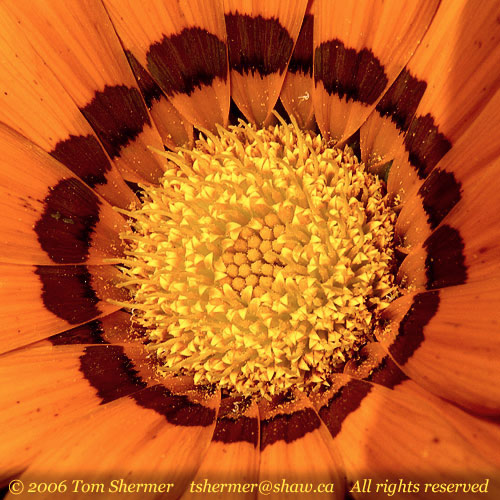 |
|
There were lots of
flying insects visiting this flower bed, and so I spent a fair
amount of time next to it taking photos of them.
My first insect subject
was a small (6-7mm) fly that didn't light on the flowers themselves,
but rather on a nearby leaf. He wasn't there long, and I only
got one distant (relatively speaking) photo of him. The angle
I had turned out bad for my light placement, and so I ended up
with serious reflection problems in the photo.
I really liked the
insect, though, so rather than discarding the photo I toned the
reflections down a bit in Photoshop. They're still a little too
much, but at least you can see why I liked this guy. His color
is remarkable: metallic blue on the head, metallic green on the
abdomen and front leg. Furthermore, the metallic green on the
abdomen is spotted—green spots on a black background. Add
to that the contrasting orange grains of pollen, and you've got
one vivid fly.
|
|
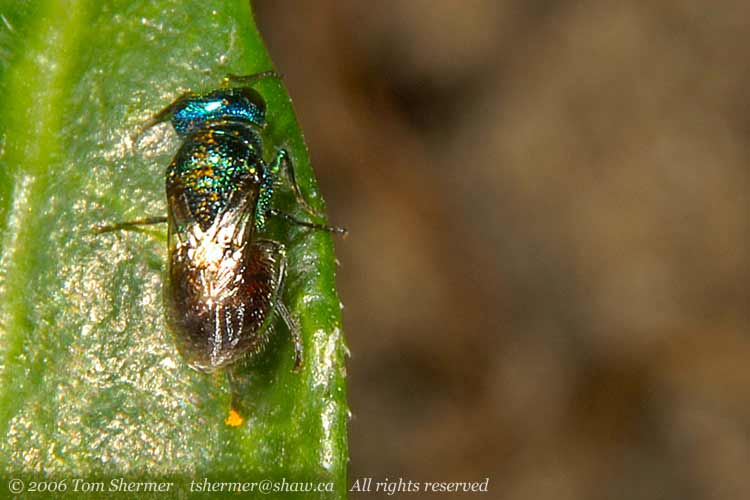 |
|
He flew off quickly,
and despite my trying to follow him, he quickly lost me. Flies
are pretty hard to track.
I mean, it's not like
they leave footprints in the mud that you can follow or anything.
Keeping an eye out
in case my fly or one of his relatives came by again, I turned
my attention to the insects buzzing around the orange flowers.
The most common of these were Honeybees, and they were the only
ones that I ended up with good photos of. The others just didn't
stay put long enough for me to move the camera in on them and
get it focussed.
Anyhow, here's a Honeybee
on one of these flowers.
|
|
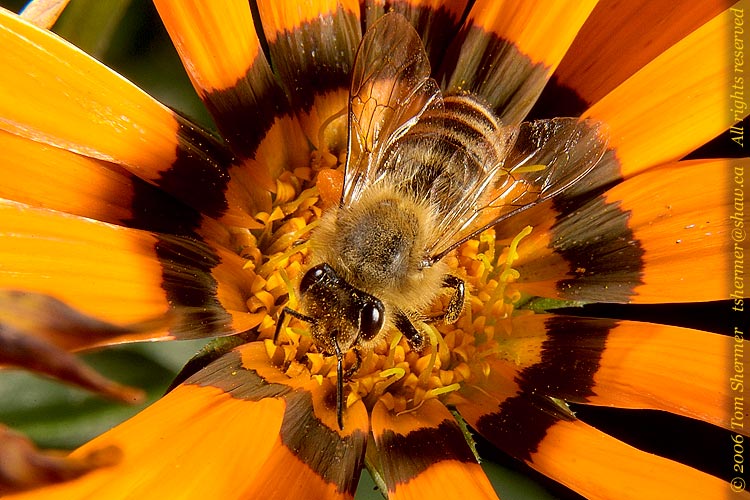 |
|
I was using my general
purpose (24-120mm) lens on an extension ring for these photos,
as I didn't yet have an adapter for fitting my lights to my macro
lens. As you can see, though, I didn't really suffer much in the
quality department for this arrangement; I'm getting excellent
detail and no noticable color fringing.
Here's another Honeybee
on another of these flowers. On this one, you can clearly see
the big orange pollen sacs on the hind legs. I'm not surprised
the sacs were so swollen; these flowers seemed to be putting off
lots of pollen.
|
|
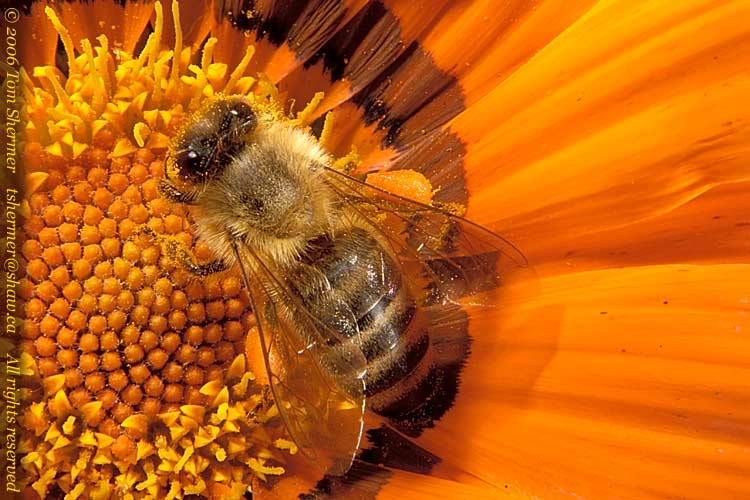 |
|
The following bee (or
maybe he's a wasp) had come by the flowerbed above, and I was
so taken by him that I followed him over to some Rudbeckias in
an adjacent planter. I was never able to get as close up on him
as I did on the Honeybees, though. The thing I found interesting
about him was the white stripes on his dark abdomen. I'd
never seen that in a bee before.
|
|
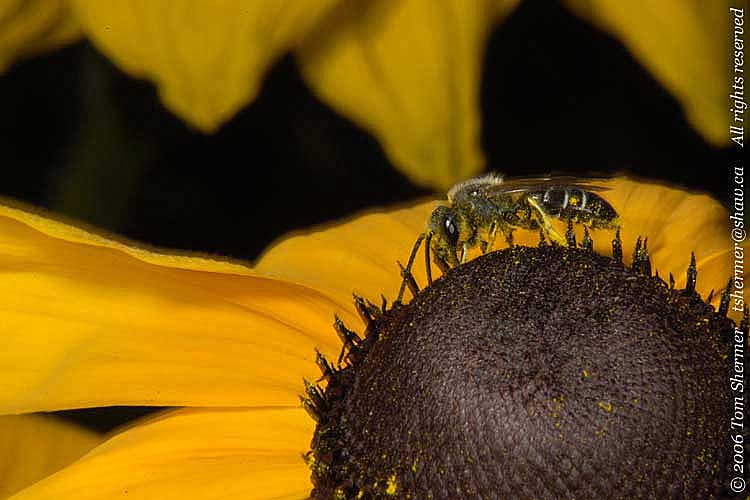 |
| He wasn't
the only interesting bee over in the Rudbeckias, though. I got really
excited when I saw the next guy. His metallic green head and thorax
mark him as a Sweat Bee. I'd never seen a Sweat Bee before, but
I had been alerted to their existence by a photo that my friend
Karla had sent me a link to a few weeks before. When I had seen
that photo, I thought that Sweat Bees were wild, exotic creatures—tropical
or something—green not being a color I normally associate with
bees. To find them buzzing around in Burnaby such a short time after
was pretty cool. |
|
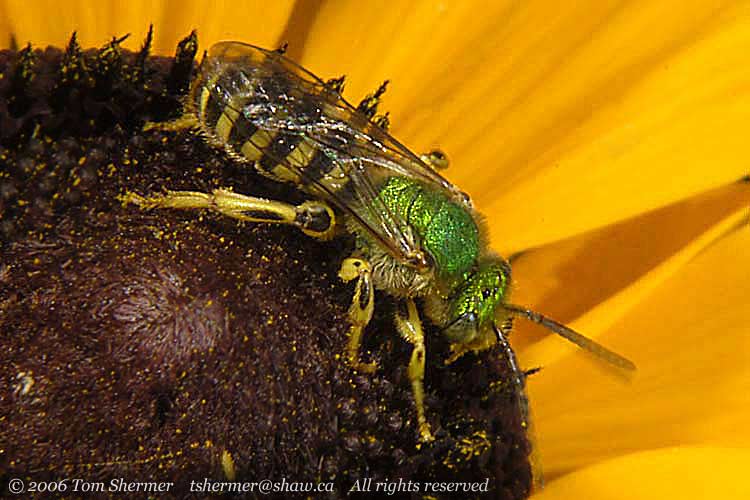 |
| I got four
photos of the Sweat Bee before he took off. I waited to see if any
more would show up, but after about 20 minutes, I hadn't seen any,
so I gave up and wandered back towards my car. On the way, I encountered
some Purple Coneflowers and was taken by the colors and structure
in the flowerhead. So I spent about ten minutes working with them,
trying various angles and distances and light placements. Here's
the one I liked the most. |
|
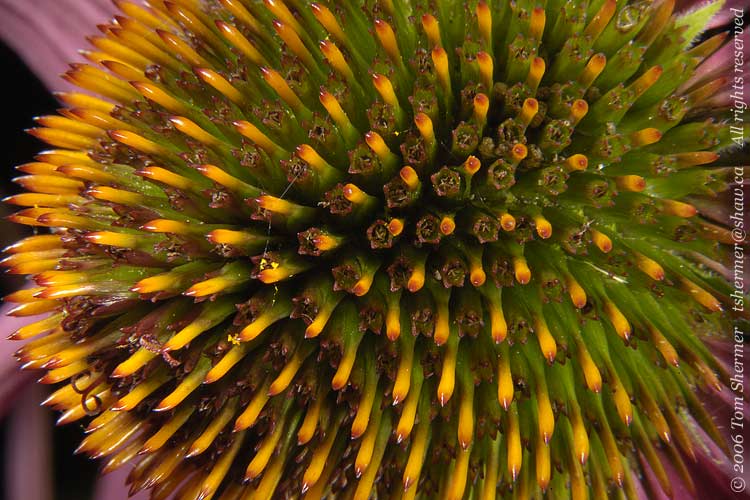 |
|
I like that one because
the left half of the photo is still and sharp, and the right half
of the photo, due to the depth of field, is blurred and almost
looks like its in motion. It's a very odd effect.
That did it for my
photos that day, as I had a few more errands to run and then a
nap to take.
Your green bee finder,
Tom
|
|
|